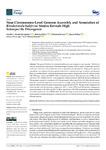2022-03-22Zeitschriftenartikel
Near Chromosome-Level Genome Assembly and Annotation of Rhodotorula babjevae Strains Reveals High Intraspecific Divergence
Martín-Hernández, Giselle C.
Müller, Bettina
Brandt, Christian
Hölzer, Martin
Viehweger, Adrian
Passoth, Volkmar
The genus Rhodotorula includes basidiomycetous oleaginous yeast species. Rhodotorula babjevae can produce compounds of biotechnological interest such as lipids, carotenoids, and biosurfactants from low value substrates such as lignocellulose hydrolysate. High-quality genome assemblies are needed to develop genetic tools and to understand fungal evolution and genetics. Here, we combined short- and long-read sequencing to resolve the genomes of two R. babjevae strains, CBS 7808 (type strain) and DBVPG 8058, at chromosomal level. Both genomes are 21 Mbp in size and have a GC content of 68.2%. Allele frequency analysis indicates that both strains are tetraploid. The genomes consist of a maximum of 21 chromosomes with a size of 0.4 to 2.4 Mbp. In both assemblies, the mitochondrial genome was recovered in a single contig, that shared 97% pairwise identity. Pairwise identity between most chromosomes ranges from 82 to 87%. We also found indications for strain-specific extrachromosomal endogenous DNA. A total of 7591 and 7481 protein-coding genes were annotated in CBS 7808 and DBVPG 8058, respectively. CBS 7808 accumulated a higher number of tandem duplications than DBVPG 8058. We identified large translocation events between putative chromosomes. Genome divergence values between the two strains indicate that they may belong to different species.
Dateien zu dieser Publikation

